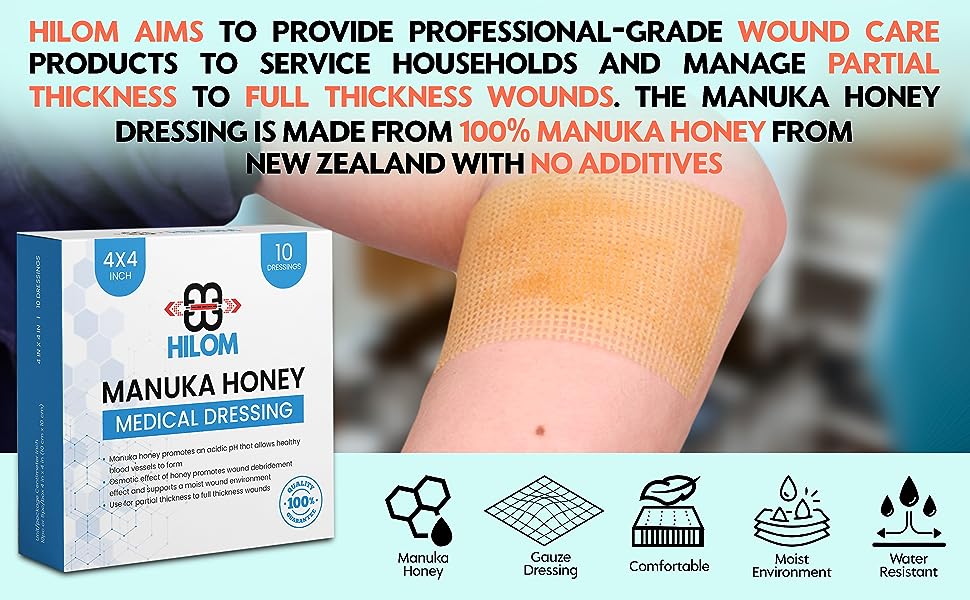
So, you’ve recently discovered the amazing benefits of using manuka honey dressing for your wounds. But now you’re left wondering, how often should you actually be changing it? In this article, we will explore the optimal frequency for changing manuka honey dressing to ensure maximum effectiveness and promote faster healing. By the end, you’ll have a clear understanding of how often you should be tending to your wounds and reaping the natural wonders of this golden elixir!
How Often To Change Manuka Honey Dressing
Importance of Changing Manuka Honey Dressing
Changing the dressing on wounds is an essential aspect of wound care, and this holds true for manuka honey dressings as well. Manuka honey dressings offer numerous benefits in wound healing, but they can only be effective if they are changed regularly. Regular dressing changes are crucial to prevent infection, promote healing, maintain a moist environment, remove exudate and dead tissue, and enhance patient comfort.
Factors Influencing Frequency of Dressing Changes
Several factors play a role in determining how often manuka honey dressings should be changed. These factors include the severity and size of the wound, the presence of infection, the amount of exudate, the type of wound, and the overall health condition of the patient. Each of these factors must be considered to determine the optimal frequency for changing the dressing.

General Guidelines for Changing Manuka Honey Dressing
While there is no one-size-fits-all answer to how often manuka honey dressings should be changed, there are some general guidelines that can help. It is crucial to follow the manufacturer’s instructions for the specific dressing being used. Additionally, it is important to personalize the dressing change schedule based on the patient’s individual needs and the characteristics of the wound. Using proper aseptic technique during dressing changes and ensuring proper wound cleansing are also essential steps to maintain wound hygiene. Regular monitoring of dressing adherence and integrity is vital to ensure that the dressing remains effective.
Signs that Indicate Dressing Change is Needed
Knowing the signs that indicate a dressing change is needed is essential for proper wound management. Increased pain or discomfort, worsening redness or swelling, offensive odor, excessive exudate, and loose or detached dressing are all signs that indicate a dressing change is necessary. If any of these signs are observed, it is important to take prompt action and change the dressing to prevent complications and promote healing.

Steps to Follow for Changing Manuka Honey Dressing
Changing a manuka honey dressing involves a series of steps that must be followed carefully. First, gather all the required materials, including sterile gloves, cleansing solution, and the new dressing. Prepare the wound and the surrounding skin by cleansing it gently. Next, remove the old dressing by carefully peeling it off. This should be done in a slow and controlled manner to minimize any trauma to the wound bed. Inspect the wound for any signs of infection or other complications. If everything is as expected, apply the new manuka honey dressing, ensuring it covers the entire wound bed. Finally, secure and cover the dressing using appropriate bandages or tape to provide stability and protection.
Frequency for Changing Manuka Honey Dressing in Different Wound Types
The optimal frequency for changing manuka honey dressing can vary depending on the type of wound. For acute wounds, such as lacerations or surgical incisions, dressing changes may be required every 1-3 days initially. As the wound progresses towards healing, the frequency can be reduced. Chronic wounds, such as diabetic foot ulcers or pressure ulcers, may require more frequent dressing changes, typically every 1-2 days. Superficial wounds may need dressing changes every 1-3 days, while deep wounds may require changes every 2-4 days. Burns and dermal ulcers often require daily dressing changes to manage exudate and promote healing.

Considerations for Specific Wound Conditions
Different wound conditions may require specific considerations when it comes to changing manuka honey dressing. For diabetic foot ulcers, it is important to closely monitor the wound and change the dressing as necessary to prevent complications. Pressure ulcers, which are often challenging to heal, may require more frequent dressing changes to promote healing and prevent infection. Surgical wounds should be assessed regularly, and dressings changed according to the surgeon’s instructions. Traumatic wounds, such as cuts or abrasions, may need frequent dressing changes initially and then decrease as the wound heals. Fungal infections may require dressing changes every 1-2 days to prevent the growth and spread of the infection.
Special Considerations for Advanced Wounds
Advanced wounds, such as those with biofilms or those that are infected, may require special considerations when it comes to dressing changes. When managing biofilms, the dressing change frequency may need to be increased, and additional steps, such as the use of enzymatic debridement agents, may be necessary. Maintaining moisture balance in the wound is crucial for proper healing, and dressings may need to be changed more frequently in advanced wounds to prevent excessive drying or excessive exudate. The use of secondary dressings may also be required in certain cases to provide additional protection and support.

Importance of Monitoring Wound Progress Regularly
Regular monitoring of wound progress is vital to ensure that the dressing change frequency is appropriate. By closely monitoring the wound, healthcare professionals and patients can assess if the current dressing regimen is effective or if any adjustments need to be made. Monitoring allows for early detection of any potential complications, such as signs of infection or delayed wound healing, and prompts timely intervention.
Consulting a Healthcare Professional for Dressing Change Guidance
While it is important to have a general understanding of how often to change manuka honey dressing, it is always advisable to consult a healthcare professional for personalized guidance. A healthcare professional can assess the specific wound, monitor the healing progress, and provide expert advice and recommendations. A collaborative approach to wound management, involving both the patient and the healthcare professional, ensures optimal outcomes and the best possible care for the wound.
In conclusion, changing manuka honey dressing regularly is crucial for wound healing and preventing complications. The frequency of dressing changes depends on numerous factors, including wound severity, infection presence, exudate amount, wound type, and the patient’s overall health condition. By following general guidelines, recognizing signs of dressing change needs, and taking appropriate steps during the dressing change process, patients can promote healing, prevent infection, and enhance their overall comfort. The considerations for specific wound conditions and advanced wounds must also be taken into account. Regular wound progress monitoring and consulting with healthcare professionals further aid in achieving optimal outcomes in wound care.
